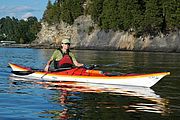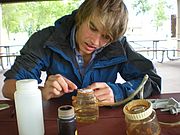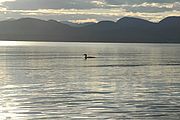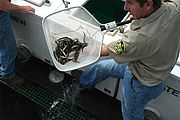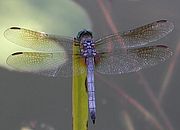LCC and the University of Vermont are collaborating on a recreational study for the Lake Champlain Paddlers Trail. Surveys were sent this summer to all LCC members who receive our annual Paddlers’ Trail guidebook. Thanks to everyone who has responded. If you haven’t returned your survey yet, please set aside some time this week to give us feedback on the Trail. By sharing your paddling experiences, what you value about getting out on the water, and your thoughts on what enhances or diminishes your recreational experience, you will help guide management of sustainable boating on Lake Champlain. We value your input and need your help! Read...
News from Selected Month
LCC volunteers have been hard at work collecting water samples to identify algae blooms around Lake Champlain. This summer has been relatively quiet. The thick pervasive bloom often seen in the lake’s northeastern bays has been less prevalent than in years past although a patchy bloom has developed in Missisquoi Bay, particularly in the eastern portion, and occasional short term blooms cropped up in other areas. Monitoring efforts continue through the Labor Day weekend. Click here for an overview of the seasons monitoring results or go to http://www.lakechamplaincommittee.org/lcc-at-work/algae-in-lake/ and scroll to the bottom of the page. Read...
If you see lights out on Lake Champlain in the next few weeks it’s probably not UFOs. The Adirondack Cooperative Loon Program will be conducting night time surveys of loons on Lake Champlain. Researchers have found that going out at night with spotlights allows them to sneak up on the birds and trap them with nets. They can then take blood samples to check for mercury and lead levels and evaluate immune response. They also tag the birds in order to track where they come from and where they are going. The project is a cooperative effort between the NY Department of Environmental Conservation, the Biodiversity Research Institute, and the Wildlife Conservation Society. Read...
The Vermont Fish & Wildlife Department gave its recently-established muskellunge restoration effort a boost in August when it stocked 250 four-month old muskellunge in the Missisquoi River Delta. The fish were donated by the New York State Department of Environmental Conservation.The muskellunge, related to northern pike, but larger, is a prized sport fish. Lake Champlain and the Missisquoi River are the only locations in New England that historically had a native muskellunge population. Muskellunge were native to Lake Champlain’s Missisquoi River and Missisquoi Bay but the population that last existed upstream of the Swanton Dam was apparently lost in the late 1970s following a chemical spill that occurred on the upper river. Read...
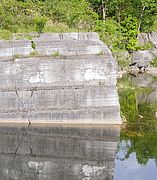
Lake Look ~ The Chazy Reef
Imagine sitting in a lounge chair with your feet in the water looking out over a tropical sea. The sun blazes away and the reefs around you teem with life. There was a time, nearly half a billion years ago, when the area we now call Lake Champlain hosted such an environment. This was before life existed on land, before the bedrock of the region had even formed.
At the time, the continental plate upon which Lake Champlain sits today was located in the lower latitudes of the Southern Hemisphere. Carbon dioxide levels exceeded today’s levels by 14 to 16 percent, and the earth was so warm that practically no ice existed. As a result, sea levels were much higher and the continental shelf was covered by a shallow arm of the Iapetus Ocean. In this arm, some of the world’s earliest reefs developed. Read...
Their names can evoke spine-chilling fear - bog haunter, pond hawk, shadow dragon, widow skimmer - or elfin magic - jewel wing, aurora dancer, sedge sprite. They are the subject of old wives tales about sewn lips of misbehaved children or their ability to reincarnate snakes. Few animal groups inspire more colorful stories than dragonflies and damselflies. Yet, even if the wives tales are not true and the names are only fanciful, these insect masters of the sky still lead fascinating lives. Together, dragonflies and damselflies comprise the insect order Odonata or “toothed ones”. Generally, dragonflies are faster and larger than damselflies, but the most reliable visual difference between the two groups is how they hold their wings when resting. Dragonflies hold their wings horizontal to the ground while most damselflies hold theirs perpendicular. Both groups are predators as adults and nymphs. Read...

